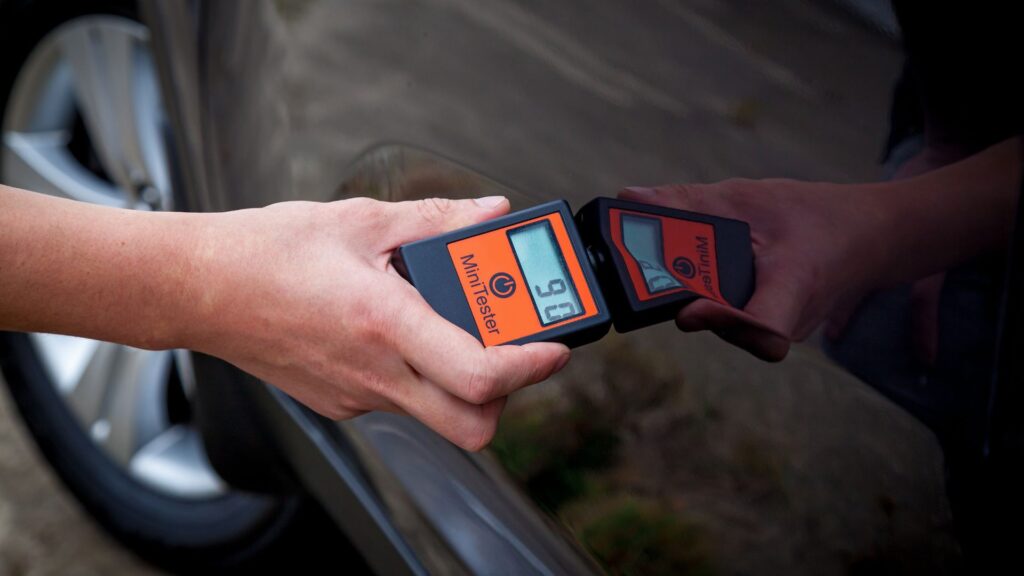Automotive paint thickness is one of the most critical yet often overlooked aspects of vehicle finishes. Proper paint thickness affects:
-
Durability and protection
-
Resale value
-
Warranty compliance
-
Repair quality
This guide explains everything you need to know about paint thickness standards, measurement techniques, and how to interpret the results.
Standard Paint Thickness Ranges
Factory Paint Jobs (OEM Standards)
-
Basecoat: 15-25 microns (0.6-1.0 mils)
-
Clearcoat: 30-50 microns (1.2-2.0 mils)
-
Total System: 45-120 microns (1.8-4.7 mils) depending on manufacturer
Aftermarket Repaints
-
High-quality resprays typically match OEM thickness
-
Cheap repaints may be significantly thinner (under 80 microns total)
Problem Areas to Watch
-
Under 40 microns = risk of premature failure
-
Over 200 microns = potential for cracking/peeling
-
Inconsistent readings = likely previous repairs
How to Measure Paint Thickness
1. Magnetic Induction (For Steel Vehicles)
-
Measures non-ferrous coatings on ferrous metals
-
Affordable and easy to use
-
Doesn’t work on aluminum or plastic parts
2. Eddy Current (For Aluminum/Non-Ferrous)
-
Uses high-frequency alternating current
-
More expensive equipment
-
Essential for modern cars with aluminum panels
3. Ultrasonic Testing (Multi-Layer Analysis)
-
Can measure individual layers (primer, base, clear)
-
Professional-grade equipment
-
Most accurate for detailed analysis
Interpreting Paint Thickness Readings
Normal Readings
-
Consistent measurements across panels (±10-15%)
-
Within OEM specifications for your vehicle
Warning Signs
-
Sudden thickness jumps between panels (possible repairs)
-
Extremely low readings (paint wear)
-
Abnormally high readings (excessive repaints)
Special Cases
-
Plastic Parts: Typically 20-30% thinner than metal panels
-
Roof/Hood: Often slightly thicker due to sun exposure
-
Door Edges: Frequently thinnest areas (40-60 microns)
Why Paint Thickness Matters
1. Resale Value Verification
-
Consistent OEM thickness suggests no major accidents
-
Helps identify hidden bodywork
2. Warranty Compliance
-
Many warranties require minimum thickness levels
-
Some void coverage if paint is too thin
3. Repair Quality Assessment
-
Reveals poor prep work (high readings)
-
Shows insufficient coverage (low readings)
4. Detailing Safety
-
Helps avoid burning through clearcoat
-
Guides paint correction aggressiveness
Professional vs DIY Measurement Options
| Method | Cost | Accuracy | Best For |
|---|---|---|---|
| Basic Magnetic Gauge | $50-150 | ±5% | DIYers, used car checks |
| Advanced Dual-Mode Gauge | $300-600 | ±3% | Serious buyers, detailers |
| Professional Ultrasonic | $1,500+ | ±1% | Body shops, appraisers |
Maintaining Proper Paint Thickness
Do’s
✔ Measure before buying used vehicles
✔ Check before major detailing
✔ Document readings for resale
✔ Compare to factory specs
Don’ts
✖ Assume all panels should match exactly
✖ Ignore sudden thickness changes
✖ Polish without knowing your clearcoat depth
✖ Buy a car without thickness verification
Conclusion: Paint Thickness as a Vital Metric
Understanding and monitoring your vehicle’s paint thickness provides valuable insights into its history, current condition, and future durability. Whether you’re a car buyer, owner, or detailing professional, adding paint thickness measurement to your evaluation process can save you from costly mistakes and help maintain your vehicle’s value.
For most consumers, investing in a basic paint thickness gauge ($100-200 range) pays for itself the first time it helps you avoid a problematic used car purchase or prevents you from damaging your clearcoat during polishing.








